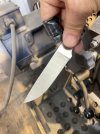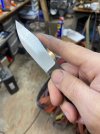- Joined
- Mar 19, 2007
- Messages
- 7,443
I am making Kiridashi's as tools for my leather customers. I am using 1/8" stock and primarily 15N20 as the steel. I do my own heat treat and am learning a lot.
I have had good advice on belts so far and would love your opinions on what belts (maker, material, backing, and the like) you would like a young maker like me to try out.
Thanks again,
Dio
I have had good advice on belts so far and would love your opinions on what belts (maker, material, backing, and the like) you would like a young maker like me to try out.
Thanks again,
Dio




